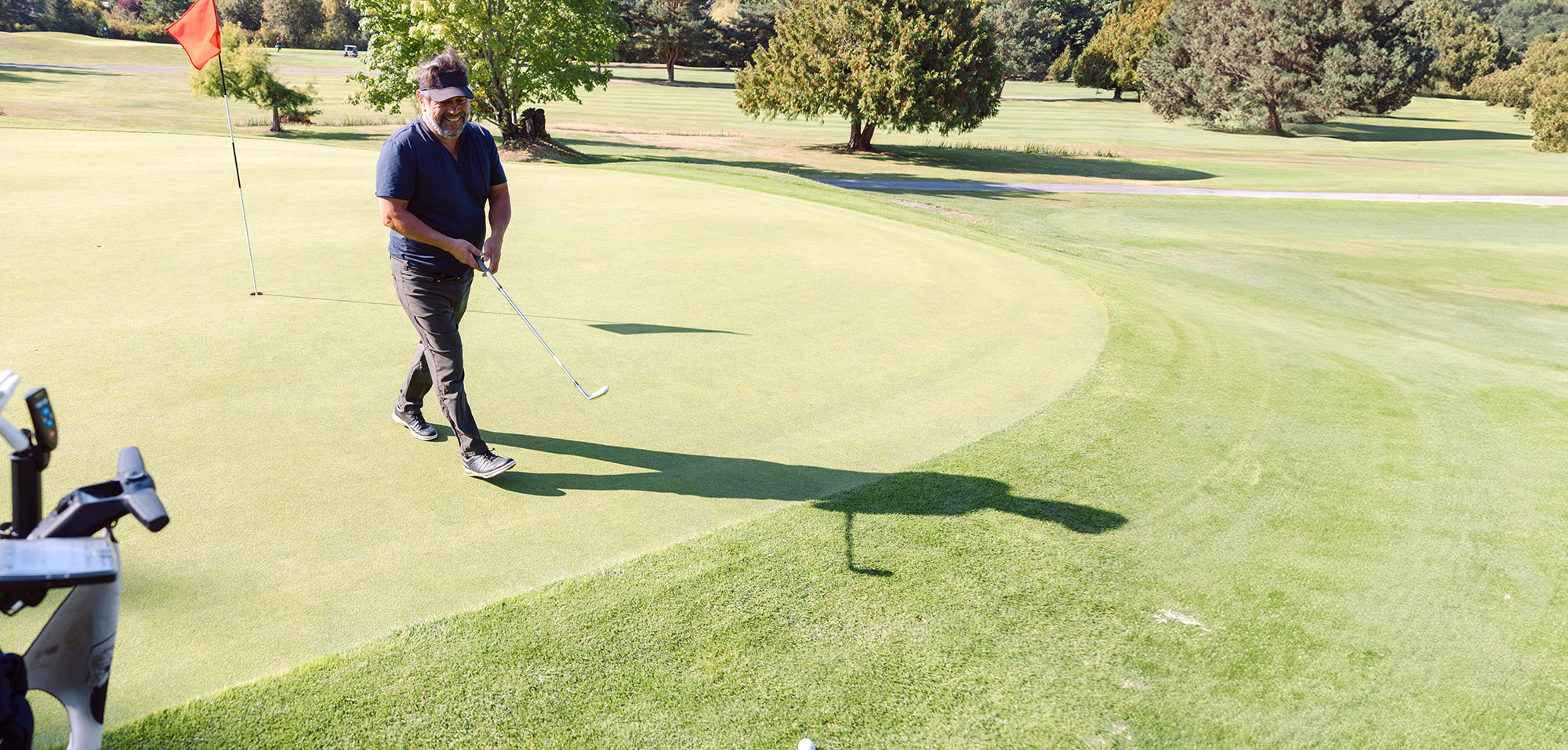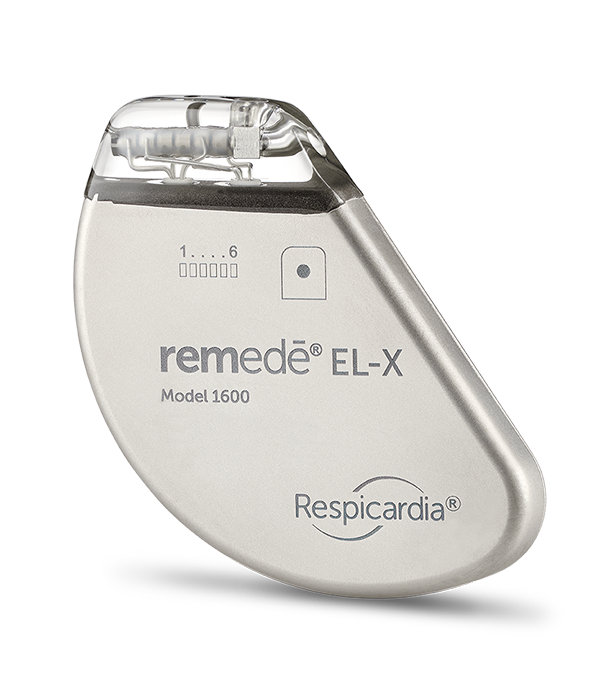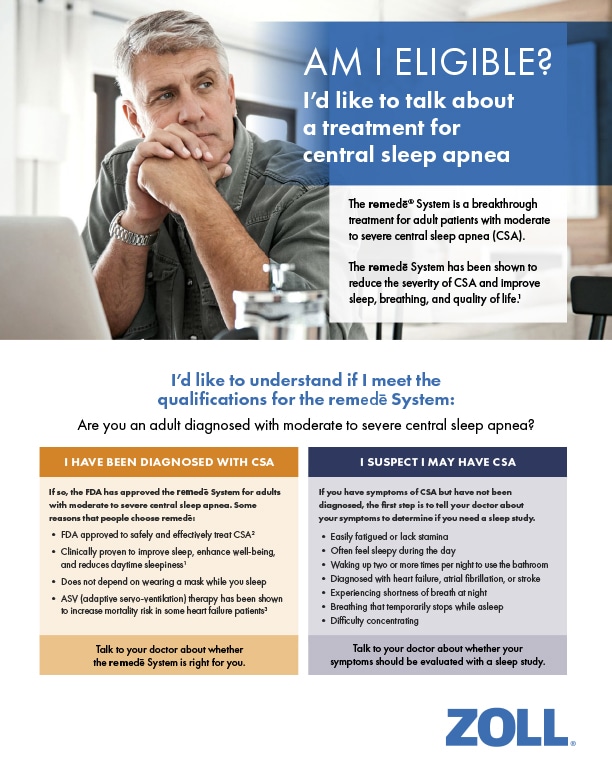
Getting the remedē® System
Interested in remedē?
If you think the remedē System may be the right treatment for your central sleep apnea (CSA), follow these steps to receive and properly adjust to your system.

Step 1: Get a diagnosis
remedē is designed for adults who have moderate to severe CSA.
If you suspect you have CSA but haven’t been diagnosed, talk to your sleep or primary care doctor about your symptoms. He or she may recommend a sleep study to help diagnose CSA and determine if you may be a candidate for the remedē System.
To connect with a remedē-trained doctor, use our locator to find one near you.
Step 2: Start the conversation
Once you’ve been diagnosed with CSA, your sleep doctor can help you understand your treatment options—including whether remedē is right for you.

If you need help navigating the conversation with your doctor, download our discussion guide.
Step 3: Understand your insurance coverage
Coverage for remedē is typically reviewed and approved by insurance providers on a case-by-case basis. After your doctor has determined whether you’re a candidate for remedē, their office staff will work with your insurance provider to secure coverage for your implantation procedure.
Commercial Insurance
Commercial insurance providers are reviewing and approving the remedē System on a case-by-case basis. Your medical team will work together with you, the hospital, the insurance company and the case management team at ZOLL to gain approval before your remedē procedure. If approved, patients can typically expect to pay the cost of any unmet deductible for the year, along with any required copay or coinsurance fee for a surgery.
Medicare
Medicare follows a policy of “Presumption of Coverage” when there is medical necessity and Medicare has not written an explicit coverage policy.
Veterans
The remedē System is available for veterans at select VA and military hospitals across the US. Visit the Finding a VA Hospital page or talk with a remedē patient liaison to see if there is a Veterans Affairs Medical Center or military hospital near you that offers the remedē System. If there is not a center near you, you may be able to utilize a program called the Veteran’s Community Care Program. Please connect with a remedē patient liaison for more information.
To speak with a dedicated VA Patient Liaison, call 1-866-788-1109 or email info@remede.zoll.com
If you have questions about insurance coverage, please email reimbursement@remede.zoll.com or call 952-540-4470 and ask to speak with a remedē Insurance Specialist.
Step 4: Adjust to life with remedē
After you receive your remedē System, follow these important instructions to help your body adjust.
Important recommendations for your remedē device:
Short Term (1-3 months):

It is typically recommended that you wear a sling to keep your arm in a low position for the first 48 hours. It is important to minimize arm movement immediately after your procedure.

Avoid raising your arm above your shoulder. Raising your arm on the side of your implant can cause the leads to get pulled out of place and require a second procedure.

Minimize upper extremities activities and exercise. Repetitive motion can cause damaging stress, lead movement, and possible failure to implanted leads.

Limit friction on the skin over the implanted area. Friction due to movement and activities could damage the device or the skin over the remedē System.
Long Term:

Avoid high powered electromagnetic fields. Electrical and magnetic equipment such as arc welding units, induction furnaces and stoves, resistance welders, radio or microwave transmitters,
linear power amplifiers have the possibility of interacting with the remedē System.

Maintain distances when using a cell phone. Cell phones can interact with the device.
- Do not place them on the chest area on the same side as the remedē device
- Maintain at least 10 inches between your cell phone and the remedē device
- Hold the phone to the ear farthest from the device

Avoid scuba diving or hyperbaric chambers. Do not dive below 10 meters (33 feet) of water or enter hyperbaric chambers above 2.0 atmospheres absolute. The pressure can damage your stimulator or leads.

Limit physical activities prone to falling. Falling can cause the device and/or the leads to move or get pulled out of place and can require a second procedure.
Additional Recommendations
- Carry your ID card. You should carry the remedē System ID card with you at all times. Because the device is placed in the chest similar to heart devices, it could be mistaken for a heart device by doctors. This could delay medical care in an emergency.
- Observe the implant site after the procedure. If you see redness or swelling at the site of the device, call your doctor without delay. Failing to call your doctor could result in a severe infection and the device may need to be removed.
- Avoid diathermy. (The production of heat in the body using electric current which may be used to treat muscle spasms, injuries and bursitis). Do not allow a healthcare provider to use any kind of diathermy on your body. Energy from diathermy can be sent through your device or leads causing tissue damage, which may result in severe injury or death. Diathermy also can damage your device or leads.
- Maintain distance from radiofrequency sources. Common radiofrequency sources (such as found in identification badges and anti-theft tags) have the potential of affecting normal remedē System operation. A distance of at least 2 feet should be kept between the implanted device and any radiofrequency source.
- Proximity to electronic equipment. Equipment such as that designed to prevent theft and airport metal detectors may affect the remedē System. Alert security personnel about the System and request a manual search if possible. If walking through a surveillance system, do not remain near this system longer than needed.
- Concerns about pregnancy. The safety and effectiveness of the remedē System has not been tested during pregnancy.
- Medical procedures. Certain medical procedures and equipment can interact with the remedē System causing changes to the remedē System or interference with the medical equipment. You should tell your physician about your remedē System prior to the use of any of the following: magnetic resonance imaging (MRI), electrocautery, radiofrequency ablation, radiation, CT scan (computed tomography), therapeutic ultrasound, external defibrillation, patient monitoring equipment or transcutaneous electrical stimulation (TENS).
- Cellular phones (extended recommendations). The remedē System contains a filter to prevent most phones from interacting with the device function. To further decrease the risk of this interaction you should observe these cautions:
- Do not place phones in the chest area (e.g. in shirt pockets) on the same side as the device.
- Maintain at least 10 inches between the device and the phone, even if the phone is not on.
- Hold the phone to the ear farthest from the device.
It is possible that phones placed close to the remedē System while it is active could result in stronger stimulation than programmed. The phone also could prevent the system from saving data about your breathing.
Patient Manual
For any additional information on the remedē device, please refer to the patient manual.

